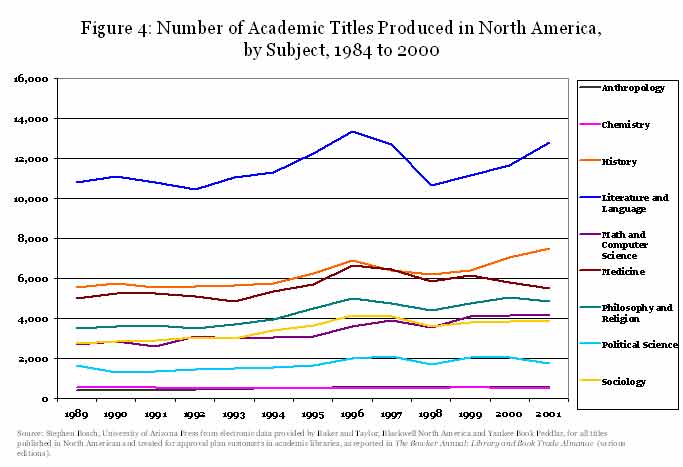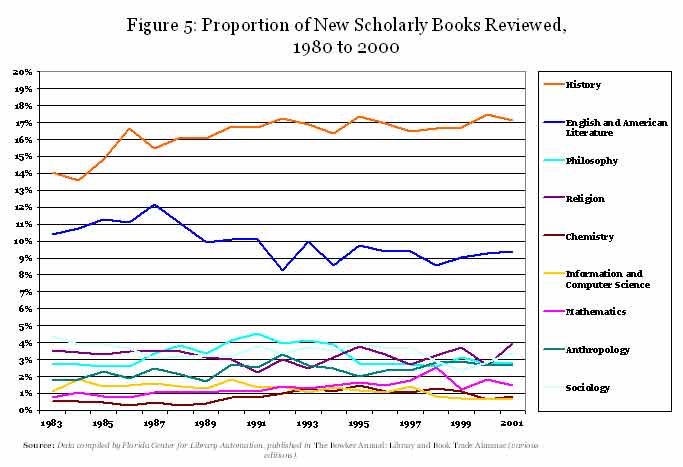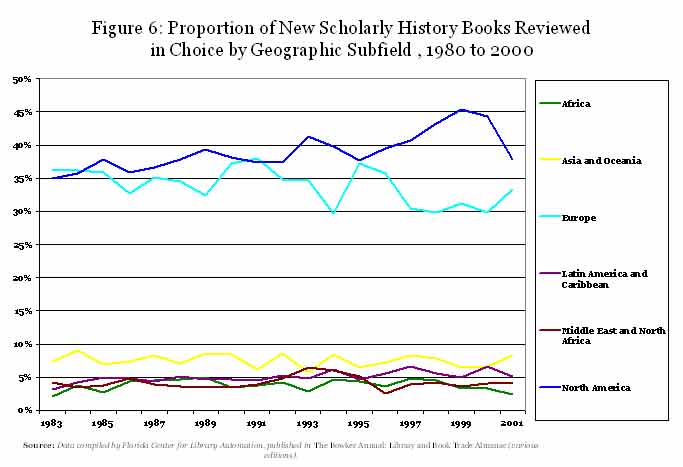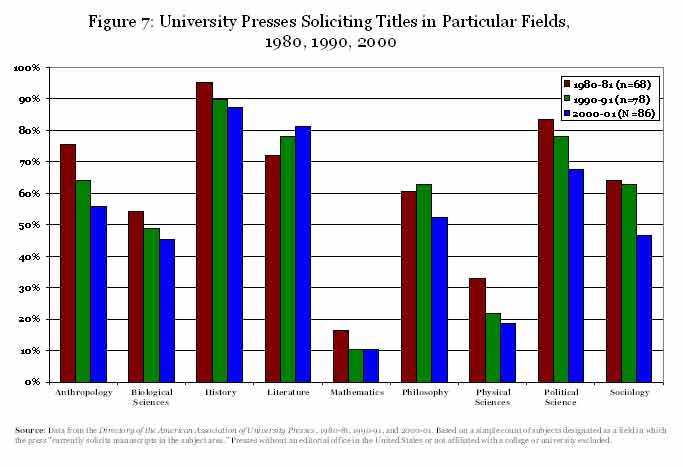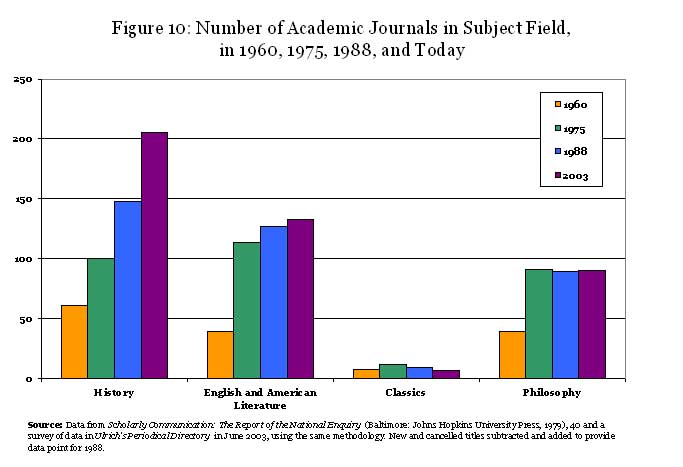Over the past few years, discussions about scholarly publishing have been invariably preceded by the word “crisis.” The university press community, research libraries, and the Modern Language Association (MLA) warn about deep and systemic problems that threaten the production of knowledge and the future careers of many junior faculty.1 Several of the factors that feed into this sense of crisis—the rising cost of serials, rising deficits at university presses, and increasing pressure on junior faculty to publish monographs—are already well known. But the actual evidence for a “crisis” often comes down to inference and anecdote.
Digging further into the available data turns up a range of useful—albeit imperfect—information. Examining the evidence for the history field reveals why so many in the profession seem untroubled by the problems at university presses, but also provides ample cause for concern among all who care about the future of the profession.
Despite the alarm, history as a field appears quite successful at finding publishing outlets, as commercial publishers and university presses are producing an unprecedented number of history books. Yet there are significant disparities in the available publishing outlets for different regions and periods, particularly for work on earlier periods and regions outside the United States. While cloudy, future trends for the field as a whole seem quite alarming. As a discipline, history is particularly tied to the (flagging) health and welfare of university presses, which produce almost 50 percent of the new titles in the field (a good 10 percent higher than other humanities and social science fields, and more than twice the rate of many of the natural sciences). So as a result, their troubles are sure to become ours in due time. Their troubles arrive at a particularly inauspicious time, as a fast-growing cohort of junior faculty will be coming up for tenure in the next decade and running up against the increased reliance on monographs as a criterion for tenure. This suggests the need for greater care in the way we consider and describe the problems of today, and a certain urgency in addressing the problems of tomorrow.
Defining the “Crisis”
It appears that the research library community initiated the discussion about an impending crisis, warning in the mid-1990s that explosive growth in the cost of scientific, technical, and medical (STM) journals were soaking up resources for monograph expenditures.2 Given that the research libraries purchase between 60 and 80 percent of new scholarly monographs, the producers and consumers of such literature had to take note, and the evidence there was quite abundant.3 The costs of STM journals rose more than 600 percent between 1982 and 2002, with certain fields like chemistry increasing 752 percent (Figure 1). In comparison, prices of journals in fields like history and literature only rose by about 250 percent over the same period, and the prices of academic books only rose about 70 percent.
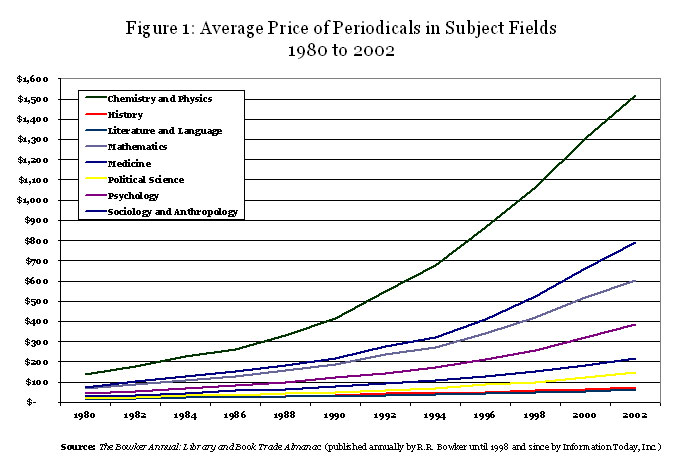
When combined with the growing technology costs associated with new catalogues and databases over this same period, this put many libraries in a severe budget pinch.4 Libraries at research universities (the largest purchasers of monographs and scholarly periodicals) cut their purchases of monographs by more than a quarter between 1986 and 2001 (Figure 2). While the upward trend in the last few years might seem positive, staff at the Association for Research Libraries dismisses the change, suggesting that this just reflects increased purchases of electronic copies of titles, many of which libraries already have on the shelves.
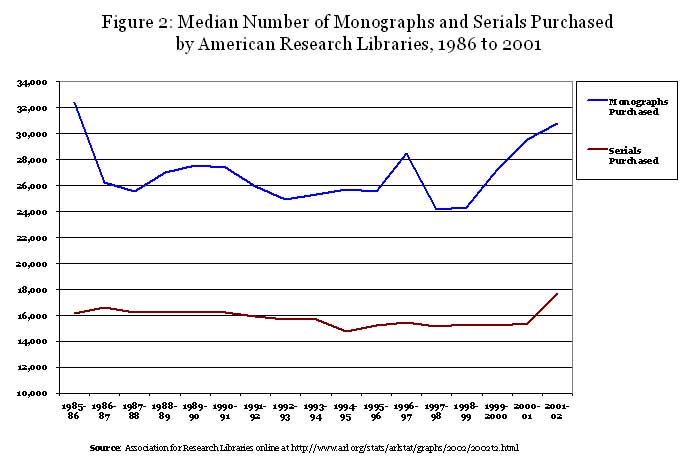
Given their prominence as purchasers of scholarly monographs, many anticipated that these reductions would have a negative effect on scholarly publishing and university presses. This served to frame the discussion of the crisis in scholarly publishing through much of the late 1990s and provided part of the rationale for the AHA’s Gutenberg-e program.5
The STM effect was just one of the problems that afflicted university presses over the past few years. They also had to confront declining library sales, new distribution channels like superstores and the Internet, and cutbacks in university subsidies and funding.6 This past December, a special committee noted a wide range of interconnected problems in this area, observing that “the same universities that have reduced the proportional budgets available for library acquisitions in the humanities and for scholarly press subsidies have also raised standards for tenure, thereby leading to increasing production of manuscripts submitted to presses.”
Despite these problems, university presses and other scholarly publishers did not—as may be expected—cut back on the number of new titles produced. Quite the contrary, they actually increased the number of new titles in the pipeline and met budgetary challenges by making other adjustments such as changing the number of copies they printed for each title, and altering the mix of titles to include more textbooks and works with a wider appeal.7
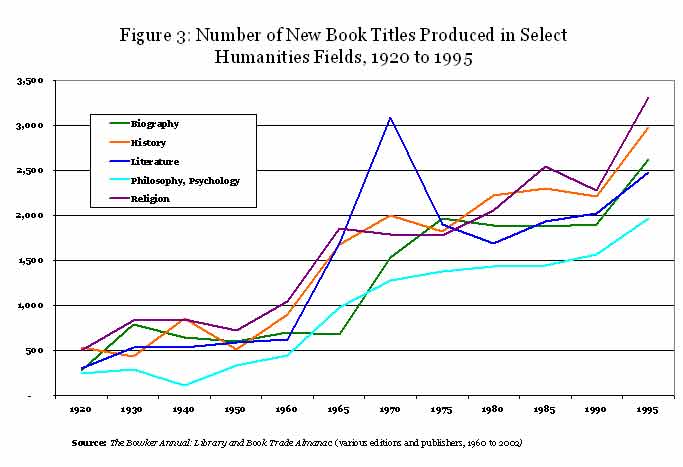
Books, Monographs, and University Presses
Tracing these broad trends in the publishing industry tells us very little, however, about the impact on a specific discipline like history. Although the data is fairly sketchy, there is some encouraging news. The number of new book titles in history is at or near unprecedented levels even on the basis of the most conservative estimates.8 Between 1920 and 1995, the production of history books more than quadrupled (Figure 3). Viewed against all titles produced, history books slipped a bit, from almost 9 percent of all the books produced in 1920 to about 4.5 percent in the mid-1970s. But history has been on the upswing in recent years, even as the total number of new titles increased. According to the Library and Book Trade Almanac, history titles accounted for 6.5 percent of all new book titles in 2000.
Of course, this tells us very little about our more specific concerns with the production of new history scholarship, particularly monographs, over this timespan. However, the available evidence is rather encouraging for historians. Looking at books recommended for purchase by academic libraries, we find that the annual number of academic history books grew by more than 25 percent between 1989 and 2000 (Figure 4). In comparison, titles in the fields of language and literature only increased by about 8 percent over the same period, while one of the fields driving the cost increases in journal prices—chemistry—experienced a real decline of 10 percent.
Another good indicator of history’s position relative to other fields can be found in the number of books reviewed in Choice, the trade journal of the Association of College and Research Libraries, and a critical resource in determining academic library purchases. History titles have enjoyed clear preeminence in the journal’s selection of titles for review and recommendation over the past 15 years, rising from 14 to 17 percent of all books reviewed, growing from 784 to 964 titles per year (Figure 5).
Nonetheless, these numbers mask significant disparities in different subfields in history. Here the evidence can be somewhat confusing because the different sources all have different ways of parsing the field. One of the three firms making buying decisions for academic libraries recommends almost as many titles in European history as in the history of North America, with titles on Asia close behind. However, this count includes a number of titles from overseas publishers, which inflate the number of histories of other regions. So this provides, at best, only an imperfect measure of the number of titles competing for library dollars. A slightly better measure, the history titles reviewed in Choice show a significant advantage for histories of North America (Figure 6).
We can write with much greater precision about the field’s dependence on the university presses. Since 1996, history was—by one measure—the only field where university presses produced more than 40 percent of all new titles.9 Currently, history appears on the lists of more university presses than any other discipline. According to the 2000–01 American Association of University Presses Membership Directory, 87 percent of the university presses listed history as a subject in which they were actively soliciting manuscripts. This has slipped a little bit over the past two decades, as newer and smaller presses started up specializing in other fields (Figure 7).
Even in this case, though, various subfields in history are treated very differently (Figure 8). North American history is preeminent among the subjects university presses are seeking, appearing on 84 percent of the lists. What is perhaps most notable in that chart is the erosion of interest in fields outside the United States. In 2001, Asian history was treated by half as many university presses as in 1981, falling from 43 percent to just 21 percent of the lists. While the number of university presses seeking U.S. history titles was slightly higher at the end of that span, at least 23 percent fewer presses treated the other fields.
We cannot measure the effect this has had on the actual production of titles in those fields, but the Blackwell’s data highlights some marked disparities (Figure 9). The predominance of U.S. history titles is masked by the field’s separation into North America and Western Hemisphere categories (which would obviously include a significant number of books about U.S. involvement in Central and South America). Even with that caveat though, during the six years covered, U.S. history comprised about 48 percent of the university press titles in history, while European and Asian history each supplied another 20 percent of the new titles. African history comprised just 4 percent of the titles produced.
When compared to other disciplines, the large proportion of titles being produced in history has a good financial rationale, as the field enjoys unusual success in selling to a wider audience.10 This allowed presses to sell more copies for less. As a result, history was the only humanities and social sciences field in which book prices failed to double between 1980 and 2000.
Makings of a Tenure Crisis
As all this indicates, significant changes are taking place in the production of scholarship that could have grave effects on the health of history in higher education. For more than a decade now, the historical profession has suffered from an imbalance between the sharp increases in the number of new PhDs and lagging growth in the number of new jobs. Without significant growth in the number of new monographs published over the next few years, the same imbalance between supply and demand seems likely to carry over onto the tenure track.
In the 2000–01 academic year, more than 21 percent of the full-time faculty were on the tenure track, up from near 14 percent just five years earlier. There is every reason to expect this proportion will remain elevated—and perhaps even grow—as a profound generational shift is taking place in the history faculties at American colleges and universities. By the end of this decade, we estimate that more than half of the instructional staff in history departments will have received their PhD since 1990.11 But simply getting the job is not the last important hurdle in an academic career. While there is remarkably little data about the number of programs that demand publications for tenure, the requirement now appears to be generally accepted, even for faculty at liberal arts colleges.12 Hence, the health of the scholarly publishing system could become a critical problem in the coming years, if many junior faculty members can’t publish their first books.
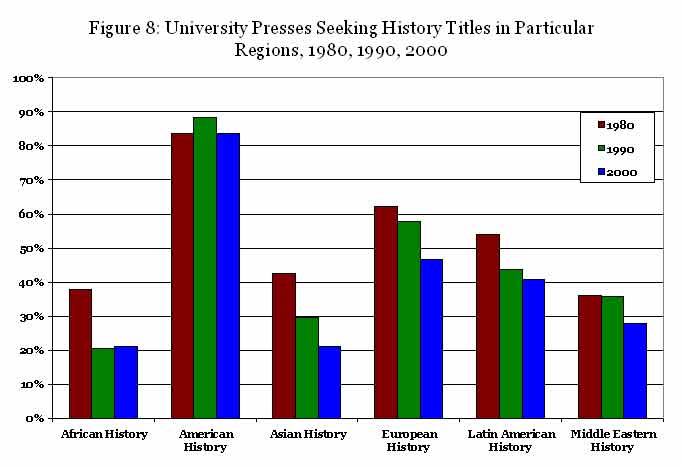
A host of unquantifiable factors play into this problem that we simply cannot answer here. We cannot discern from the data how many of the new books are first monographs—as opposed to textbooks, essay collections, and monographs by established historians. But if the production of monographs stagnates as many expect, the large and growing cohort of new faculty moving toward tenure will soon swell the ranks of those on the outside of the academy looking in (or consigned to itinerancy as adjunct faculty).
This is certainly not the only reason to worry about the health of scholarly publishing. As a field, history has long privileged the book as the culmination of historical research, and the field’s traditional belief in the progressive building, brick-upon-brick, of historical evidence makes the health of scholarly publishing vitally important to the discipline.
The potential for a tenure crisis to grow out of this situation in the near future gives the issue a particular urgency. This has led some, like MLA president Stephen Greenblatt, to argue that departments should “rethink what we need to conduct responsible evaluations of junior faculty members.”
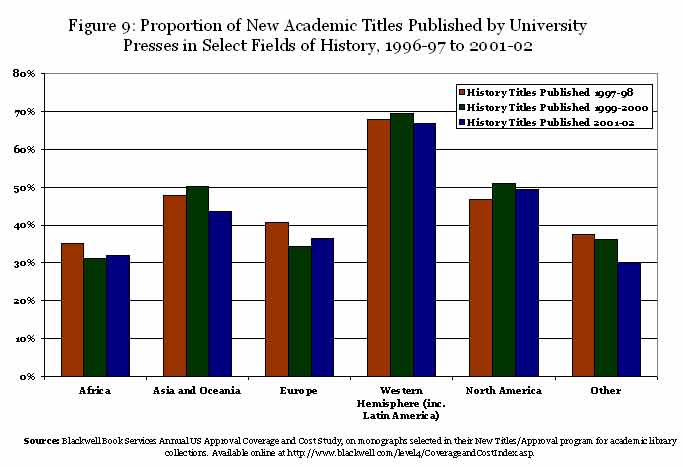
Alternative Outlets
The solutions proposed by the MLA and others would give added weight to articles that appear in peer-reviewed journals and monograph published electronically. Both options seem particularly promising for the field of history.
The field is currently at a high water mark in the number of academic journals devoted to history.13 According to Ulrich’s Periodical Directory, there are currently 203 journals in history classified as “Academic/Scholarly” (seemingly using peer review as a measure for this category). That is more than double the number of history journals reported in 1975 and more than three times the number published in 1960 (Figure 10). Just in the past three years, Ulrich’s reports 16 new journals in the field, ranging from generalist publications, like the Journal of the Historical Society, to specialized journals, like American Communist History.
The growth in the number of journals has managed to outpace growth in the number of new scholars in the field. John Higham noted this trend back in 1965, observing the field’s tendency to create new journals “to foster some previously neglected domain of historical knowledge.”14 The trend could only have been accelerating as he was writing. Between 1960 and 1975, as the discipline produced 1.5 times the number of PhDs conferred as in field’s first 90 years, it expanded the number of journals by 1.7 times.15 In the following 25 years, the number of PhDs produced increased 1.5 times over the boom and bust years between 1960 and 1975, while the number of journals more than doubled. As Figure 10 also attests, this differs markedly from other humanities fields, which have seen relatively little growth over the past 28 years even in the fields of modern languages and literature, which followed a similar growth curve in the number of PhDs.
In addition to the growing number of journal outlets, the history discipline also has an unusual number of electronic outlets for new scholarship. The AHA’s Gutenberg-e project and the American Council of Learned Societies History E-Book project are fairly unique among the humanities disciplines as organized efforts to publish monographs online.
So the field is fortunate in having a number of alternative outlets for history scholarship, if it chooses to credit them in the academic reward system. Taken as a whole the view for the history field is thus troubled, but not lacking in resources and opportunities to remedy the situation. But those remedies will not happen without some action by the field; action that will only become more urgent with each month and year that passes.
The Research Division is studying these issues and welcomes comments from the members and the field. Please send comments by e-mail to rtownsend@theaha.org.
Robert B. Townsend is assistant director for research and publications. This report was prepared with the guidance of Roy Rosenzweig (George Mason Univ.), the Association’s vice president for research, and with assistance from Katherine Hijar and Mériam Belli.
Notes
1. See MLA Ad Hoc Committee on the Future of Scholarly Publishing, “The Future of Scholarly Publishing,” Profession (December 2002), 172–86; Carlos J. Alonso, “Having a Spine—Facing the Crisis in Scholarly Publishing,” PMLA 118 (2003): 217–23; Sanford G. Thatcher, “Thinking Systematically about the Crisis in Scholarly Communication,” paper presented to the American Association of University Presses conference, “Specialized Scholarly Monograph or How Can I Get Tenure If You Won’t Publish My Book?” (September 11–12, 1997); Willis G. Regier, “5 Problems and 9 Solutions for University Presses,” Chronicle of Higher Education 49:40 (June 13, 2003): B7; and John F. Baker, “‘We Are All in This Together’,” Publishers’ Weekly 250:22 (June 2, 2003), 26–8. [Back to text]
2. See Anthony M. Cummings, et al., University Libraries and Scholarly Communication (New York: Andrew W. Mellon Foundation, 1992), 83–101; “The Scholarly Communication Crisis,” (a subsidiary of the Association of Research Libraries); and the papers presented at the conference on “ The Specialized Scholarly Monograph in Crisis or How Can I Get Tenure If You Won’t Publish My Book?” September 11–12, 1999. [Back to text]
3. Dave Bogart, ed., The Bowker Annual: Library and Book Trade Almanac (New Providence, N.J.: Information Today, Inc., 2002), 393. [Back to text]
4. According to Michael Gorman, dean of library sciences at California State University at Fresno, “the tendency is to have a book budget that is, essentially, what is left over when the other materials budgets are determined.” Michael Gorman, “The Economic Crisis in Libraries: Causes and Effects,” in Richard E. Abel and Lyman W. Newlin, eds., Scholarly Publishing: Books, Journals, Publishers, and Libraries in the Twentieth Century (New York: John Wiley & Sons, Inc., 2002), 266. [Back to text]
5. Robert Darnton, “The New Age of the Book.” New York Review of Books, 18 Mar. 1999, 5-7, and Sandria Freitag, “The Endangered Monograph,” Perspectives (October 1995), 3. [Back to text]
6. Lynn Garrett, et al., “The Evolution of Scholarly Publishing: Academics Are Learning a New Language to Reach a More Diverse Audience,” Publishers Weekly, 249:45 (November 11, 2002): SC2–8 and Scott Smallwood, “The Crumbling Intellectual Foundation,” Chronicle of Higher Education 49:4 (September 20, 2002), A10. [Back to text]
7. These trends were noted quite early in the 1990s. Cf. Robert A. Carter and Daisy Maryles, “University Presses in the Marketplace: Many—but Not All—Scholarly Publishers Are Aggressively Seeking Trade Sales, Sometimes Treading on Commercial Turf,” Publishers Weekly 238:23 (May 24, 1991): 16–21 and, more recently, Regier, “5 Problems and 9 Solutions.” One finds a slightly more positive spin on these changes in articles like Ken Wissoker, “Scholarly Monographs Are Flourishing, Not Dying,” Chronicle of Higher Education (September 12, 1997). The latter works tend to depict the adjustments as sensible, and largely successful adjustments to new economic realities. [Back to text]
8. This data is based on a tabulation of data on American Book Title output over the past 80 years as published in the Bowker Annual: Library and Book Trade Almanac. We can only offer estimates based on percentages in 2000, because the editors of the almanac made a technical change in the way they count the number of new titles (shifting from the Library of Congress’s MARC database to their own Books in Print database). This had the effect of almost doubling the number of new titles. The absolute number of new titles in their data rose from 539 titles in 1920 to 2,975 in 1995, and bounced up to 7,931 new titles in 2000 under the new method of counting. [Back to text]
9. Blackwell Book Services Annual US Approval Coverage and Cost Study, on monographs selected in their New Titles/Approval program for academic library collections. [Back to text]
10. Albert N. Greco, “The General Reader Market for University Press Books in the United States, 1990–99, with Projections for the Years 2000 to 2004,” Journal of Scholarly Publishing 32, 2 (January 2001), 74–6. See also Barbara Hoffert, “Book Report 2002: The Amazon Effect,” Library Journal (February 15, 2002): 38. [Back to text]
11. Robert B. Townsend, “Job Market Report 2001: Openings Booming . . . but for How Long?” Perspectives (December 2002): 3. [Back to text]
12. James S. Fairweather, Teaching, Research, and Faculty Rewards (University Park: National Center on Postsecondary Teaching, Penn State University, 1993), 11; Franklin H. Silverman, Publishing for Tenure and Beyond (Westport, Conn.: Praeger Publishers, 1999), 7–8; and Howard R. Bowen and Jack H. Schuster, American Professors: A National Resource Imperiled (New York: Oxford University Press, 1986), 118 and 147. [Back to text]
13. The principal contours of the argument are laid out in Martha Kyrillidou, “Spending More for Less…,”ARL Newsletter 204 (June 1999). [Back to text]
14. John Higham, History: Professional Scholarship in America (Baltimore: Johns Hopkins Univ. Press, 1965, 1983), 32–35. [Back to text]
15. In the first 90 years of the discipline (pre-1960) 7,630 history PhDs were conferred. Between 1961 and 1975, the field produced 11,321. Even though the pace slowed considerably between 1975 and 1989, the rapid acceleration through the 90s added another 16,626 PhDs between 1976 and 2000. Using the combined numbers between the Directory and the AHA membership lists as indicators, we estimate that about 17,000 history PhDs are currently active in the field, with around 7,000 non-PhDs who maintain a strong interest in the field. [Back to text]
Tags: Viewpoints Scholarly Communication
Comment
Please read our commenting and letters policy before submitting.

